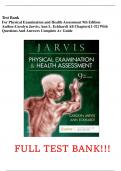Test Bank
For Physical Examination and Health Assessment 9th Edition
Author:Carolyn Jarvis; Ann L. Eckhardt All Chapters[1-32] With
Questions And Answers Complete A+ Guide
FULL TEST BANK!!!
, PHYSICAL EXAMINATION AND HEALTH ASSESSMENT 9TH EDITION JARVIS TEST BANK
Test Bank - Physical Examination and Health Assessment 9e (by Jarvis) 2
TABLE OF CONTENTS
1. Evidence-Based Assessment
2. Cultural Assessment
3. The Interview
4. The Complete Health History
5. Mental Status Assessment
6. Substance Use Assessment
7. Family Violence and Human Trafficking
8. Assessment Techniques and Safety in the Clinical Setting
9. General Survey and Measurement
10. Vital Signs
11. Pain Assessment
12. Nutrition Assessment
13. Skin, Hair, and Nails
14. Head, Face, Neck, and Regional Lymphatics
15. Eyes
16. Ears
17. Nose, Mouth, and Throat
18. Breasts, Axillae, and Regional Lymphatics
19. Thorax and Lungs
20. Heart and Neck Vessels
21. Peripheral Vascular System and Lymphatic System
22. Abdomen
23. Musculoskeletal System
24. Neurologic System
25. Male Genitourinary System
26. Anus, Rectum, and Prostate
27. Female Genitourinary System
28. The Complete Health Assessment: Adult
29. The Complete Physical Assessment: Infant, Young Child, and Adolescent
30. Bedside Assessment and Electronic Documentation
31. Pregnancy
32. Functional Assessment of the Older Adult
, PHYSICAL EXAMINATION AND HEALTH ASSESSMENT 9TH EDITION JARVIS TEST BANK
Test Bank - Physical Examination and Health Assessment 9e (by Jarvis) 3
Chapter 01: Evidence-Based Assessment
MULTIPLE CHOICE
1. After Completing An Initial Assessment Of A Patient, The Nurse Has Charted That His Respirations Are
Eupneic And His Pulse Is 58 Beats Per Minute. These Types Of Data Would Be:
a. Objective.
b. Reflective.
c. Subjective.
d. Introspective.
ANS: A
Objective Data Are What The Health Professional Observes By Inspecting, Percussing, Palpating, And
Auscultating During The Physical Examination. Subjective Data Is What The Person Says About Him Or
Herself During History Taking. The Terms Reflective And Introspective Are Not Used To Describe Data.
DIF: Cognitive Level: Understanding (Comprehension)
MSC: Client Needs: Safe And Effective Care Environment: Management Of Care
2. A Patient Tells The Nurse That He Is Very N e r vno uusr, Si si nn aguts be a. Ct eod m
, And Feels Hot. These Types Of Data Would Be:
a. Objective.
b. Reflective.
c. Subjective.
d. Introspective.
ANS: C
Subjective Data Are What The Person Says About Him Or Herself During History Taking. Objective Data Are
What The Health Professional Observes By Inspecting, Percussing, Palpating, And Auscultating During The
Physical Examination. The Terms Reflective And Introspective Are Not Used To Describe Data.
DIF: Cognitive Level: Understanding (Comprehension)
MSC: Client Needs: Safe And Effective Care Environment: Management Of Care
3. The Patients Record, Laboratory Studies, Objective Data, And Subjective Data Combine To Form The:
a. Data Base.
b. Admitting Data.
, PHYSICAL EXAMINATION AND HEALTH ASSESSMENT 9TH EDITION JARVIS TEST BANK
Test Bank - Physical Examination and Health Assessment 9e (by Jarvis) 4
c. Financial Statement.
d. Discharge Summary.
ANS: A
Together With The Patients Record And Laboratory Studies, The Objective And Subjective Data Form The
Data Base. The Other Items Are Not Part Of The Patients Record, Laboratory Studies, Or Data.
DIF: Cognitive Level: Remembering (Knowledge)
MSC: Client Needs: Safe And Effective Care Environment: Management Of Care
4. When Listening To A Patients Breath Sounds, The Nurse Is Unsure Of A Sound That Is Heard. The
Nurses Next Action Should Be To:
a. Immediately Notify The Patients Physician.
b. Document The Sound Exactly As It Was Heard.
c. Validate The Data By Asking A Coworker To Listen To The Breath Sounds.
d. Assess Again In 20 Minutes To Note Whether The Sound Is Still Present.
NURSINGTB.COM
ANS: C
When Unsure Of A Sound Heard While Listening To A Patients Breath Sounds, The Nurse Validates The Data To
Ensure Accuracy. If The Nurse Has Less Experience In An Area, Then He Or She Asks An Expert To Listen.
DIF: Cognitive Level: Analyzing (Analysis)
MSC: Client Needs: Safe And Effective Care Environment: Management Of Care
5. The Nurse Is Conducting A Class For New Graduate Nurses. During The Teaching Session, The Nurse
Should Keep In Mind That Novice Nurses, Without A Background Of Skills And Experience From Which To
Draw, Are More Likely To Make Their Decisions Using:
a. Intuition.
b. A Set Of Rules.
c. Articles In Journals.
d. Advice From Supervisors.
ANS: B
Novice Nurses Operate From A Set Of Defined, Structured Rules. The Expert Practitioner Uses Intuitive
Links.DIF: Cognitive Level: Understanding (Comprehension)




